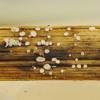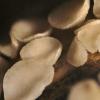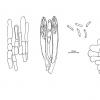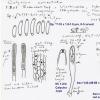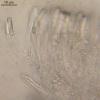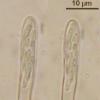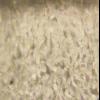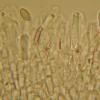
30-11-2025 12:53
 Edvin Johannesen
Edvin Johannesen
White short-stipitate apothecia found on thin twig

30-11-2025 10:47
 William Slosse
William Slosse
I recently found a collection of small Peziza sp.

27-11-2025 12:01
Thomas Læssøehttps://svampe.databasen.org/observations/10496727

27-11-2025 11:46
Thomas Læssøehttps://svampe.databasen.org/observations/10493918

17-09-2025 10:50
Heather MerryleesHi there!I am hoping for any advice on the identif

29-11-2025 08:40
 Andreas Millinger
Andreas Millinger
Hello,on a splintered part of a branch on the grou

28-11-2025 16:45
Nogueira HéctorNovember 23, 2025 Requejo de Sanabria (León) SPAI

25-11-2025 14:24
Thomas Læssøehttps://svampe.databasen.org/observations/10490522

27-11-2025 15:41
Thomas LæssøeSpores brownish, typically 4-celled; 26.8 x 2.4;

27-11-2025 11:31
Thomas LæssøeCollectors notes: Immersed ascomata, erumpent thro
Salut à tous,
I hope someone out there can help....
I have found this Ascomycete in December in an often flooded area on Carex stems (South England).
Apothecia 0.2 - 0.8 mm
Ascospores: 6 - 10.2 x 1.6 - 2.2 µm
Asci tips dull red in Lugol
No KOH reaction
Croziers present (I think!)
Distinct scarlet colour around some marginal cells (is this significant?)
The excipulum cells are hyaline, which I think rules out Mollisia and leaves me somewhere around Psilachnum (?)
I have some (poor) photomicrographs if my illustration is not good enough!
Merci beaucoup,
Nick


gratulation to your precise drawing! Clearly you have Calycina cruenta, a specues close to C. discreta but on monocots, and spores a bit larger and more allantoid.
I attach a drawing by Torsten Richter and some of my photos. Croziers are actually present (on your drawing they can be assumed to be present).
C. discreta exists with and without croziers (probably two different species).
Zotto
Current Name: Helotium cruentatum P. Karst., Bidr. Känn. Finl. Nat. Folk 19: 139 (1871)
Synonymy:
Calycina cruentata (P. Karst.) Kuntze, Revis. gen. pl. (Leipzig) 3(2): 448 (1898)
Pezizella cruentata (P. Karst.) Raitv., in Raitviir & Sirko, Eesti NSV Tead. Akad. Toim., Biol. seer 17: 327 (1968)

Changes in IF are actually done very slowly. I sent two lists to Paul Kirk, one a year ago and another 8 months ago. Only the former was so far included.
Zotto

1. there exist molecular data of Calycina herbarum, and they are very far from Hymenoscyphus but close to Roseodiscus which has a very similar type of apical ring.
2. C. cruentata has much in common with C. herbarum, concerning teleomorph morphology, so I would bet that it falls in the same clade once sequenced.
3. Helotium Tode 1790 was excluded from the Ascomycetes long ago, it is now a Basidiomycete (synonym of Omphalina). Helotium Fr. 1849 has as type Cudoniella acicularis, but is overruled by Helotium Tode.
.Zotto
nomenclatural and taxonomic problems are not solved by writing letters to Paul Kirk. Likewise, Paul Kirk will not write thousands of new combinations. It is very interesting how you try to manipulate. "Hey" is not respectful, Mr. Baral. Yan

one word too much. I apologize.
But I do not wish to continue in this way. If you have arguments against my statements please tell us. So far I did not notice any.
Be sure that everybody is manipulating the fungi when doing taxonomy. The name changes will never stop, they are at lerst partly a sign of progress. By the way, generic limits are a matter of taste, and molecular data can only help in better understanding relationships, they are not the final truth alone.
I noticed that you wonder why I give so often an opinion in this forum. Mabey you are not aware of my studies. My time is actually quite limited and I do not do this in order to see me in the forum, but to help anybody who collects ascomycetes. I could also stop giving my opinion, maybe you wish to do this job?
Zotto

I think your contributions and sharing of knowledge is extremely important, esp for mycologists like me who resides faaaar away from the institutions, libraries and herbarium!??
For many of us these kinds of forum is our only way forward. And sometimes I think the future of mycology (even for the few proffessionals) lie in the hands of contributions from skilful amateurs.
Keep the good work up everybody!!

And do not think that my determinations are always correct - how should they be! Sometimes the solution will later be found with a first misdetermination.
Those who did the input in Index Fungorum were surely not always specialists of the group concerned, so the IF data are often not much perfect. The worst you can do is to trust all these data as being in accordance with the presently published knowledge. There are also quite a lot of bibliographic errors that we have corrected, mainly for the Orbiliaceae.
Zotto
Thank you Zotto. Many thanks for to spend your time with us.We have learned many with you and want to continue doing it.
The asturian mycologists

I too am extremely grateful, from having met you here in Yorkshire last year, to numerous online contacts with you my enthusiasm for the Ascomycota has been given much impetus (those thanks should also extend to many others on this excellent site).
There is always the danger that when anything appears in a book or on a website that it can take on a spurious authority.
One problem arises in that IndexFungorum is a nomenclatural list - not a taxonomic one. The waters are muddied rather by incorporating SpeciesFungorum into IF (note how the page colour changes from grey to green). SpeciesFungorum is CABI's taxonomic opinion, harvested from various sources, and can never be 'the final word'. From necessity it is often well behind current opinions, something I have found when working on the Peronosporales for example.
Amitiés
Chris

I think he contributes to the pleasure that most of us get from this forum where discussion and different opinions are perfectly allowed (hitherto !) and to the - above all- friendly atmosphere of Ascofrance .
Michel

I hope to read you in the forum still a lot of times.
Sharing with you then meeting you in forays have been highly important for studying helotiales and I will never thank you enough for that. And I know you will have plenty of testimonies in this way.
Recois toutes mes amitiés
François

this forum is a bunch of friends, tied by our love to ascomycetes.
Many of them know each other personally but at least by their real names.
And I am very grateful to Zotto sharing his knowlege with us, as I am grateful to every contributor here as well, showing and discussing their or others finds.
Martin
Zotto - Thanks for your valuable time, C.cruenta looks perfect, I also found some excellent illustrations on Stip Helleman's site which are very close to mine indeed.
Can anyone explain the red colour around the marginal cells I observed? I didn't include it in my illustration as I wasn't sure whether it was significant or just my camera picking up things it shouldn't....
I'm looking forward to learning form you all - My enthusiasm for Ascomycetes is growing, but I'm at the bottom of a very steep learning curve!
Merci encore,
Nick

I'm just a humble little amateur that couldn't advance without the help of this forum, composed of excellent mycologists (and better people), as Zotto, who help to improve the poor knowledge of a inexperienced like me.
Thank you very much to all, please, continue with this work.
Best wishes.

sorry for my late reply. I wish to tell you my deepest thanks for your collaboration. I actually learn a lot in this forum. Many species I know only through your documentations. So please keep on this valuable way of exchange.
Yes, Chris, you are right. When I use to say Index Fungorum I should better say ISF or Species Fungorum. I always start a srach with IF but never with SF, so I think only IF.
Zotto

Nick, I think it is air trapped by the surrounding water.
Raúl

I send you all my friendships and my thanks for your collaboration?
Christian
